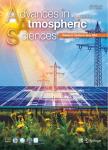Characteristics of Lake Breezes and Their Impacts on Energy and Carbon Fluxes in Mountainous Areas
在多山的区域的精力和碳流动上的湖微风和他们的影响的特征作者机构:State Key Laboratory of Atmospheric Boundary Layer Physics and Atmospheric ChemistryInstitute of Atmospheric PhysicsChinese Academy of SciencesBeijing 100029China University of Chinese Academy of SciencesBeijing 100864China Yunnan Meteorological ObservatoryKunming 650034China Dali National Climatic ObservatoryDali 671003China
出 版 物:《Advances in Atmospheric Sciences》 (大气科学进展(英文版))
年 卷 期:2021年第38卷第4期
页 面:603-614页
核心收录:
学科分类:07[理学] 070601[理学-气象学] 070602[理学-大气物理学与大气环境] 0706[理学-大气科学]
基 金:supported by funds from the National Key Research and Development Program of China (Project no: 2017YFC1502101) the National Natural Science Foundation of China (Projects no: 41775018, and 41805010)
主 题:sensible heat flux latent heat flux carbon dioxide flux lake breeze mountain breeze
摘 要:In mountainous lake areas, lake–land and mountain–valley breezes interact with each other, leading to an extended lake breeze. These extended lake breezes can regulate and control energy and carbon cycles at different scales. Based on meteorological and turbulent fluxes data from an eddy covariance observation site at Erhai Lake in the Dali Basin,southwest China, characteristics of daytime and nighttime extended lake breezes and their impacts on energy and carbon dioxide exchange in 2015 are investigated. Lake breezes dominate during the daytime while, due to different prevailing circulations at night, there are two types of nighttime breezes. The mountain breeze from the Cangshan Mountain range leads to N1 type nighttime breeze events. When a cyclonic circulation forms and maintains in the southern part of Erhai Lake at night, its northern branch contributes to the formation of N2 type nighttime breeze events. The prevailing wind directions for daytime, N1, and N2 breeze events are southeast, west, and southeast, respectively. Daytime breeze events are more intense than N1 events and weaker than N2 events. During daytime breeze events, the lake breeze decreases the sensible heat flux(Hs) and carbon dioxide flux(F_(CO_2)) and increases the latent heat flux(LE). During N1 breeze events, the mountain breeze decreases Hs and LE and increases F_(CO_2). For N2 breeze events, the southeast wind from the lake surface increases Hs and LE and decreases suppress carbon dioxide exchange.



